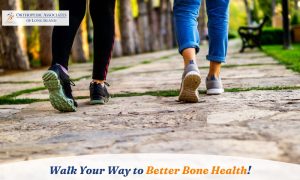How Daily Walking Supports Lifelong Bone Health
When it comes to building healthy habits for life, few are as simple—or as powerful—as walking. At Orthopedic Associates of Long Island, we emphasize the importance of low-impact movement for maintaining strong bones, especially as we age. Daily walking doesn’t just support cardiovascular health or help manage weight—it plays a crucial role in protecting your bones and preventing osteoporosis-related injuries. Unlike high-intensity workouts that can sometimes strain joints or lead to overuse injuries, walking provides a safe, accessible way to stay active at any age. Whether you’re just starting a fitness routine or recovering from an orthopedic condition, walking offers a steady, sustainable path toward better musculoskeletal health. It requires no special equipment, no gym membership, and can be done virtually anywhere—making it one of the most effective forms of lifelong preventive care.
Why Walking Matters for Bone Health:
Bones are living tissue, and like muscles, they respond to regular use. Weight-bearing exercises like walking stimulate bone remodeling, a natural process where old bone is broken down and replaced with new bone tissue. This helps increase bone density and strength—key factors in reducing the risk of fractures, especially in the hips, spine, and legs. The spine, in particular, is central to overall skeletal health. Vertebral fractures due to weakened bones are a common complication of osteoporosis—and walking helps maintain the strength of the spinal column, improves posture, and reduces the risk of compression injuries.
The Long-Term Benefits of Consistent Walking:
Incorporating just 30 minutes of walking into your daily routine can make a significant difference in your long-term orthopedic health. Not only does it strengthen bones, but it also supports joint flexibility, improves posture and balance, and boosts circulation—all of which contribute to healthier movement patterns. For spine health, regular walking can alleviate stiffness, promote core engagement, and reduce pressure on the lower back. And since walking is a weight-bearing activity, it’s especially beneficial for older adults looking to slow bone loss and maintain independence.
Tips to Walk Safely and Effectively:
-
Wear supportive, cushioned footwear to reduce joint impact
-
Choose even, stable walking surfaces whenever possible
-
Start with shorter walks and gradually build up your endurance
-
Maintain good posture: head up, shoulders relaxed, and stride steady
-
Stay hydrated and stretch gently before and after your walk
If you’re managing an orthopedic condition—such as back pain, arthritis, or recovering from a spinal injury—consult with your provider before starting a new routine. We can help you tailor a walking plan that supports your goals while protecting your joints and spine.
At Orthopedic Associates of Long Island, we believe in proactive care for lifelong strength and mobility. Whether you’re recovering from an injury, looking to stay active, or concerned about bone and spine health as you age, our team is here to guide you every step of the way.
